
Leucopogon plumuliflorus is a species of flowering plant in the heath family Ericaceae and is endemic to the south-west of Western Australia. It is a weakly erect shrub with egg-shaped leaves and spikes of white or pinkish-white, tube-shaped flowers.

Leucopogon pendulus is a species of flowering plant in the heath family Ericaceae and is endemic to the south-west of Western Australia. It is an erect, straggling shrub with oblong leaves and white, tube-shaped flowers that are bearded inside.

Styphelia planifolia is a species of flowering plant in the heath family Ericaceae and is endemic to the south-west of Western Australia. It is a bushy shrub with narrowly oblong or lance-shaped leaves with a small, sharp point on the tip, and white, tube-shaped flowers.

Leucopogon assimilis is a species of flowering plant in the family Ericaceae and is endemic to the south of Western Australia. It is an erect, slender shrub with linear or lance-shaped leaves and pink to white, tube-shaped flowers.

Styphelia blepharolepis is a species of flowering plant in the heath family Ericaceae and is endemic to the south-west of Western Australia. It is an erect shrub with sharply-pointed, oblong to lance-shaped leaves and small flowers in racemes of two to five in leaf axils with small bracts and bracteoles about 1 mm (0.039 in) long. The sepals are about 2 mm (0.079 in) long and the petals are joined at the base forming an urn shape about 4 mm (0.16 in) long with lobes longer than the petal tube.

Styphelia brevicuspis is a species of flowering plant in the heath family Ericaceae and is endemic to the south-west of Western Australia. It is an erect, bushy shrub with oblong leaves with a small point on the tip, mostly about 1 mm (0.039 in) long. The flowers are arranged in groups of two or three in leaf axils with small bracts and bracteoles about half as long as the sepals. The sepals are about 4.2 mm (0.17 in) long and softly-hairy, the petal tube about the same length as the sepals but the petal lobes shorter than the petal tube.

Styphelia breviflora is a species of flowering plant in the heath family Ericaceae and is endemic to the south-west of Western Australia. It is an erect, spindly, glabrous shrub that typically grows to a height of up to about 1.5 m. It has oblong to lance-shaped or linear leaves 4–9 mm (0.16–0.35 in) long on a short petiole and with a small, rigid point on the tip. The flowers are borne singly or in pairs in leaf axils on a short peduncle with small bracts and bracteoles about half as long as the sepals. The sepals are about 2 mm (0.079 in) long and the petals white and about 4 mm (0.16 in) long, the petal lobes longer than the petal tube.

Styphelia concinna is a species of flowering plant in the heath family Ericaceae and is endemic to the south-west of Western Australia. It is a low-lying shrub with many branches. Its leaves are egg-shaped or oblong, 2–4 mm (0.079–0.157 in) long with a small point on the end and the ends rolled under. The flowers are arranged singly or in pairs in leaf axils on a short peduncle. The sepals, petal tube and petal lobes are about 2 mm (0.079 in) long.

Styphelia flavescens is a species of flowering plant in the heath family Ericaceae and is endemic to the south-west of Western Australia. It is a shrub with oblong leaves and white, tube-shaped flowers that are densely bearded on the inside.

Styphelia glaucifolia is a species of flowering plant in the family Ericaceae and is endemic to the south-west of Western Australia. It is an erect or spreading shrub with linear, sharply-pointed leaves, and white, tube-shaped flowers.
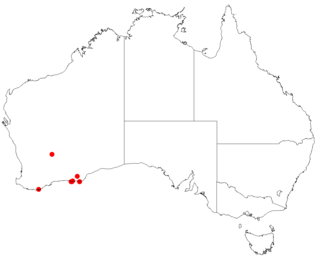
Leucopogon multiflorus is a species of flowering plant in the family Ericaceae and is endemic to the southwest of Western Australia. It is a rigid shrub with crowded, sharply-pointed, linear to lance-shaped leaves, and white, tube-shaped flowers usually in groups in leaf axils.
Cryptandra stellulata is a flowering plant in the family Rhamnaceae and is endemic to the southwest of Western Australia. It is a shrub with spiny branches, narrowly oblong to linear leaves and spike-like clusters of 2 to 12 white, tube-shaped flowers.

Leucopogon opponens is a species of flowering plant in the heath family Ericaceae and is endemic to the south-west of Western Australia. It is an erect, slender shrub with its leaves arranged in opposite pairs, and white, tube-shaped flowers.
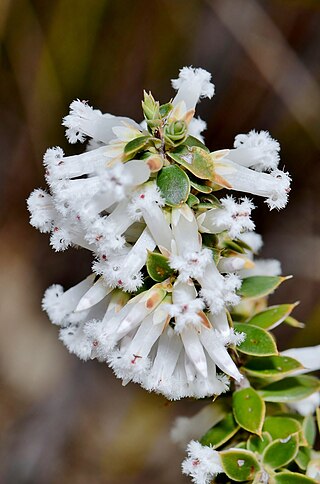
Styphelia erubescens is a species of flowering plant in the heath family Ericaceae and is endemic to the south-west of Western Australia. It is an erect shrub with variably-shaped leaves with a small, sharp point on the tip, and white, pink or red, tube-shaped flowers.
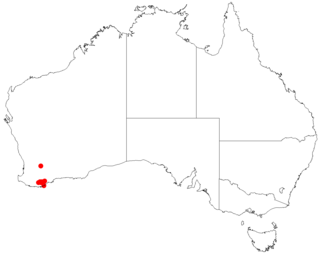
Leucopogon pogonocalyx is a species of flowering plant in the heath family Ericaceae and is endemic to a restricted part of the south-west of Western Australia. It is an erect shrub with wand-like branches. Its leaves are erect, egg-shaped, 4–6 mm (0.16–0.24 in) long with a rigid, sharply-pointed tip on the end. The flowers are borne in leaf axils in pairs or threes with bracts and broad bracteoles about one-third as long as the sepals. The sepals are about 2 mm (0.079 in) long with bearded edges, and the petals are about 4 mm (0.16 in) long, the petal lobes as long as the petal tube and densely bearded.
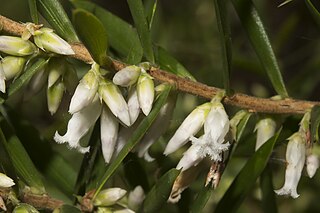
Leucopogon propinquus is a species of flowering plant in the heath family Ericaceae and is endemic to the south-west of Western Australia. It is an erect, rigid shrub with linear leaves and white, tube-shaped flowers usually arranged in pairs or threes in leaf axils.

Leucopogon racemulosus is a species of flowering plant in the heath family Ericaceae and is endemic to the south-west of Western Australia. It is an erect, rigid shrub with linear leaves and white, tube-shaped flowers usually arranged in pairs or threes in leaf axils.

Leucopogon strictus is a species of flowering plant in the heath family Ericaceae and is endemic to the southwest of Western Australia. It is an erect, rigid, more or less glabrous shrub with oblong to lance-shaped leaves and white, tube-shaped flower arranged singly or in pairs in leaf axils.
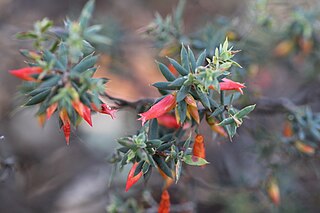
Styphelia epacridis is a flowering plant in the family Ericaceae and is endemic to the south-west of Western Australia. It is a straggling shrub with lance-shaped or linear leaves with a sharp point on the tip, and red, tube-shaped flowers arranged singly in leaf axils.

Styphelia erectifolia is a species of flowering plant in the heath family Ericaceae and is endemic to the south-west of Western Australia. It is a shrub with often wand-like, erect or ascending, usually softly-hairy branches and a thick, woody trunk. The leaves are linear, tapering to a short point, the edges turned down or rolled under and usually less that 12 mm (0.47 in) long. The flowers are red, and nearly sessile, with bracteoles about 2 mm (0.079 in) long at the base. The sepals are about 6.5 mm (0.26 in) long, the petal tube 8.6–11 mm (0.34–0.43 in) long with lobes 4 mm (0.16 in) long and bearded inside.




















